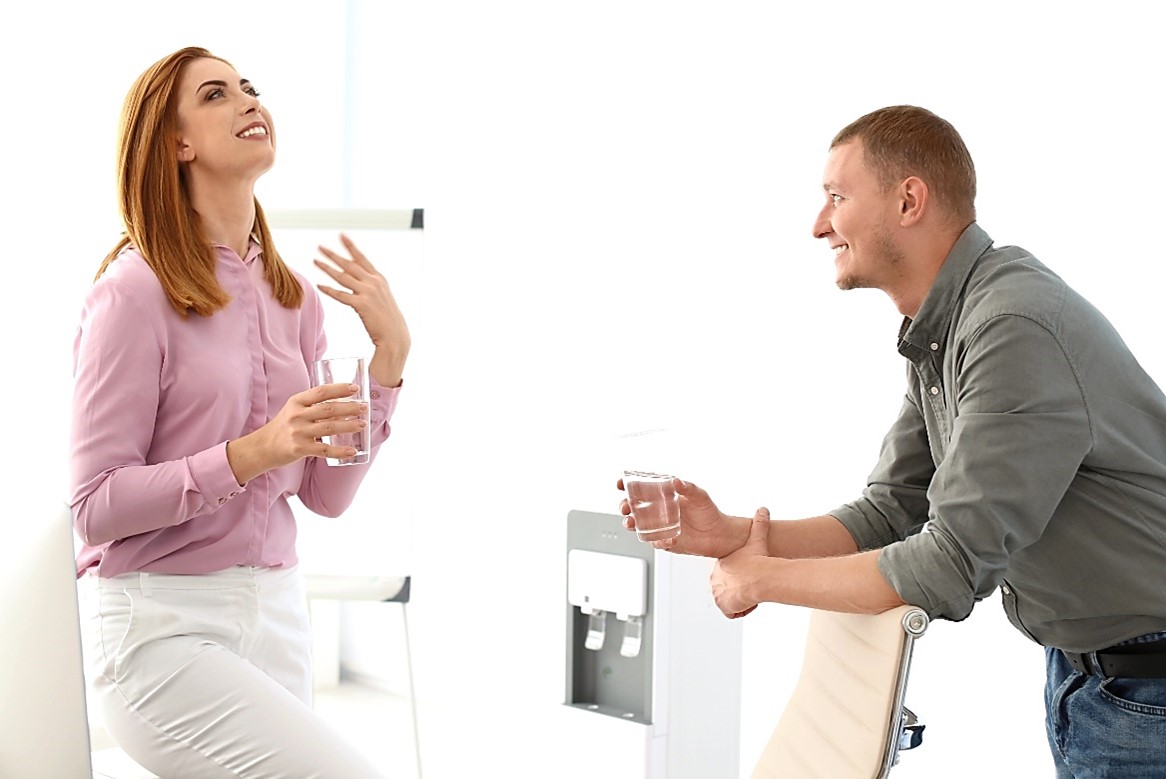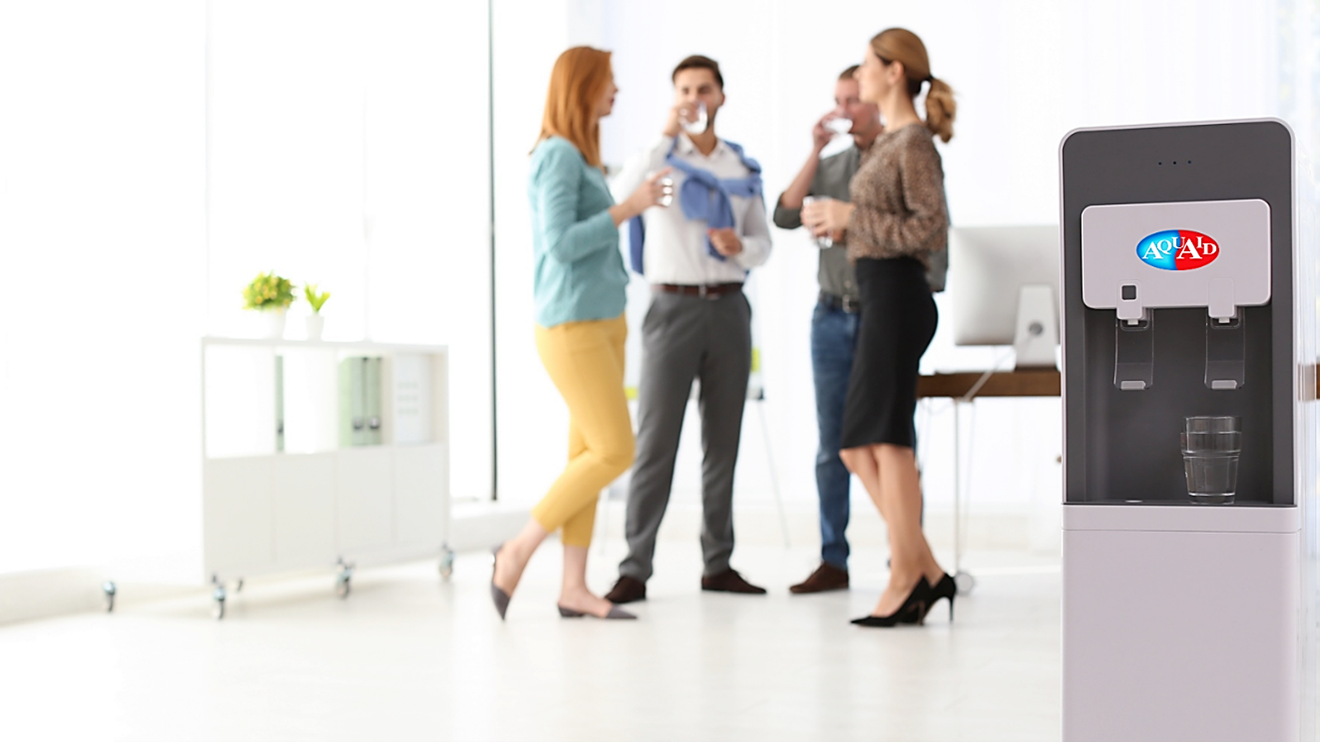
by Fern Shaw | Jan 16, 2025 | water cooler, water cooler, Water Coolers
Drinking water is essential for our physical health. It keeps us hydrated, helps our organs function properly and can even improve our skin. But can something as simple as drinking water help spark inspiration? While it might sound far-fetched, there’s a compelling link between hydration and cognitive function, which can indirectly influence our ability to be inspired.
Our brains are about 75% water. When we’re dehydrated, even mildly, our cognitive functions can take a hit. Studies have shown that dehydration can lead to:
Reduced concentration and focus. It becomes harder to stay on task and delve deep into thoughts.
Impaired memory. Both short-term and long-term memory can be affected, making it difficult to recall information or connect ideas.
Increased fatigue and brain fog. Feeling sluggish and mentally foggy can stifle creativity and make it harder to generate new ideas.
When we’re properly hydrated, our brains function more efficiently. This can translate to clearer thinking, improved focus and a greater ability to process information, all of which are conducive to inspiration. Inspiration often strikes when we’re in a state of mental clarity and openness.
While drinking water alone might not magically bestow inspiration, it plays a crucial role in supporting optimal brain function and creating an environment where inspiration is more likely to strike. By staying hydrated, we can enhance our cognitive abilities, improve our mood and increase our energy levels, all of which can contribute to a more inspired and creative state of mind. So, next time you’re seeking inspiration, remember to refill your water bottle or water glass at your water cooler and drink up – it might just be the spark you need.

by Fern Shaw | Sep 30, 2024 | water cooler, Water Coolers
As a leading provider of water coolers in the UK, AquAid offers more than just standard customer benefits. For over two decades, we remain dedicated to delivering exceptional service.
A few key benefits that set us apart:
Extensive Product Range. AquAid offers a comprehensive range of high-quality water dispensing solutions tailored to the customers’ specific requirements.
Branches nationwide. AquAid’s nationwide network of 23 branches provides dedicated teams to serve customers across the UK. Each branch offers convenient local bottled water deliveries, services and support.
Rapid Delivery. A delivery time of 48-hours on our bottle-fed water coolers.
Expert Service. Our WHA-accredited engineers ensure professional installation and maintenance.
Charitable Commitment. AquAid has a strong commitment to social responsibility, supporting charities focused on the implementation of safe drinking water resources.
Benefit from our decades of experience:
With over 20 years in the industry, you can trust AquAid to provide exceptional service, using our expertise to deliver reliable and efficient solutions whatever the drinking water requirements.
We continue to expand on this expertise and experience daily thereby enabling us to continually offer the very best benefits to our customers.
To benefit from our experience & expertise while simply keeping yourself refreshed, contact us at AquAid – we’ll be delighted to assist.

by Fern Shaw | Aug 7, 2024 | water cooler, Water Coolers
In a previous part of this water dispenser series we looked at what constituted engaging conversation while gathered around the water cooler – or the ubiquitous ‘water cooler chats’.
In this, Part IV of this series, we’re edging into a slightly more topical area – that of what potentially could be appropriate water cooler topics to chat about versus what isn’t appropriate. In principle this guideline applies to all areas in the workplace but it’s more relevant as water cooler chat tends to be less formal and therefore relaxed (which is a good thing). However, when we’re more relaxed, the temptation to be more personal can potentially lead into deeper waters and put us at risk of water cooler chat faux pas.
We’re turning things upside down here and beginning with the potentially inappropriate first, in order to end on a good note.
Rather not:
- Don’t be a drama llama. Gossiping about colleagues or complaining about projects can create negativity and tension.
- Leave out the politicking and religion. These can be very divisive topics. It’s best to avoid them at work.
- Money & finances. Talking about salaries, debts or investments is generally not appropriate in a professional setting.
- Personal issues should remain personal. Avoid delving too deeply into personal problems or family issues.
- Avoid controversial social issues. There might be differing opinions, so it’s best to steer clear.
Better water cooler station banter:
- Pop Culture is a classic! Talk about new movies, binge-worthy shows, funny memes, or upcoming concerts.
- Talking about what your hobbies and interests are outside of work is a terrific way to connect with colleagues and discover shared passions.
- Local Events. Did a great new restaurant open in the area? Is there a fun festival happening this weekend? Chatting about local happenings is a wonderful way to connect.
- Discuss positive news stories, interesting scientific discoveries, or upcoming holidays. Avoid overly political or controversial topics.
- Food and drinks are a fantastic way to go. Make it seasonal to make it even better. Recommend a new restaurant you tried, share a favourite recipe, or broadcast where to find the best comfort food when it’s colder or favourite refreshing tipple or smoothie in the warmer months.
- Share your dream destinations or recent adventures. Most everyone enjoys travel stories.
When in doubt, it’s wise to err on the side of caution. Keep it light, positive and respectful of your colleagues’ backgrounds and beliefs.

by Fern Shaw | Jul 23, 2024 | water cooler, Water Coolers, water dispenser
As things heat up across the UK, so does the demand for chilled, refreshing drinking water.
At AquAid, where we’ve been in the business of providing a range of high quality water coolers and water, both spring and bottled at source, for over twenty years, we understand this more than most. That’s why it’s important to us to be able to ensure that we’re able to offer the very best in both water dispensers and bottled water.
But we’re not just about the provision on water coolers. We also firmly believe that providing water to those who may not necessarily have access to water as we do is vital.
If we struggle with keeping hydrated in this heat, take a minute and imagine what it would be like experiencing hot weather but not having access, not only to drinking water, but any water, at all. Sadly, this is a reality for millions of people around the globe, in many developing countries.
Then to this scary scenario add if you want water, you need to walk to find it. And not just down to the corner caf, but a few miles away. If you’re lucky enough to find a water source, you can’t just buy a bottle of water (or any liquid for that matter); you must fill the bucket you brought with you and walk back home, carrying the now full bucket.
The water that you’ve just fetched is most likely not safe to drink and may be so full of bacteria, that even while trying to hydrate yourself, you may very well be making yourself ill without even realising it.
This is the day-to-day existence for many communities throughout the Third World and in the summer months, lack of potable water is amplified by the heat.
That’s just one of the reasons, since our rather humble beginnings in 1998, that we chose to work with sustainable charities like The Africa Trust and Christian Aid. Using donations from AquAid, both charities work tirelessly implementing sustainable water projects for communities in need.
So, although we’re always tooting our own horn about being one of the top water dispenser providers in the U.K. we also (truly) believe in helping others less fortunate to help themselves. So, while we have you to thank, most valued customer, for your support and through your purchases making it possible for others to help themselves; isn’t it rather nice to know that when you’re sipping cool spring or bottled at source water from one of our water coolers, there’s another water well or water project being installed in Africa, bringing clean drinking water to yet another community in need?
We think so. Good on yer. Toot toot!

by Fern Shaw | Jul 18, 2024 | water cooler, water cooler, Water Coolers
With summer on the horizon and school holidays looming, it’s about that time where many Britons are prepping for the journey that will get them to their holiday destination.
Whether it’s to calm the nerves, get your holiday started en route or because it’s your custom to have a tipple when you fly, many of us indulge pre and during flight. Whatever the reasons, imbibing alcohol inflight isn’t a good idea, at all. Here’s why:
Flying already puts a strain on the body. With increased altitude comes decreased air pressure. This decreases the concentration of oxygen in the air and results in reduced oxygen in our lungs and bloodstream.
Aircraft cabins are typically dry environments. Alcohol is a diuretic, meaning it increases urine production, which can contribute to dehydration. This can exacerbate the effects of alcohol and lead to headaches and other discomforts.
Although a glass of wine, beer or spirits might seem like a good relaxant, alcohol has an adverse effect on sleep quality. Even at sea level, alcohol has been shown to elevate heart rates, which can interfere with REM sleep and disrupt cardiovascular relaxation.*
Some studies suggest that drinking alcohol and then sleeping on a flight might lower blood oxygen levels and increase heart rate, potentially putting extra strain on the cardiovascular system.
If that casual in-flight drink isn’t something you’re quick to forgo, a few tips to minimise impacts on overall health and sleep.
If you choose to drink, do so responsibly and in moderation. Take short walks around the cabin to improve circulation and prevent blood clots. Most importantly, drink plenty of water throughout the flight to counteract the dehydrating effects of alcohol and the dry cabin air.
*source: Article by Leah Worthington on National Geographic

by Fern Shaw | Jul 10, 2024 | water cooler, water cooler, Water Coolers
In Part 1 we established that chats at the water cooler do indeed still happen and in Part II we looked at the unexpected benefits that arise from such chats.
In Part III of this series, we address what makes for engaging conversation? Here are five useful tips which should help you navigate water cooler conversations.
These apply to both in-person and virtual (where applicable) conversations.
Positivity is Key
Water cooler moments are a chance to unwind and connect. Focus on positive topics and avoid work gripes or negativity. This fosters a more enjoyable and upbeat work environment.
Be Curious (to a point)
Instead of just talking about your own interests, ask questions about others’ hobbies and passions. Not only might you be surprised at what you learn but this could potentially lead to forming a better connection with co-workers in other departments you may not normally engage with.
Listen Well
Show genuine interest in what your colleagues are saying. Ask follow-up questions and avoid turning the conversation back to yourself.
Become a Conversational Catalyst
If you find a lull in the chat, come prepared with conversation starters. Share an interesting fact you learned, a funny anecdote, or ask about a recent event. This keeps the conversation flowing and shows you’re engaged.
Read the Room
If someone seems busy or disinterested, don’t force a conversation, however, if you see colleagues lingering at the water cooler station, say hello. Just be mindful of keeping the conversation concise and respectful of everyone’s time.
By using these tips, you can have engaging and appropriate water cooler chats that could well help build camaraderie with your colleagues.






